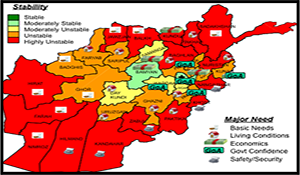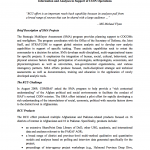PAKAF Rich Contextual Understanding of COIN

SMA PAKAF Rich Contextual Understanding (RCU) Project: Information and Analyses in Support of COIN Operations Executive Summary.
Author | Editor: Canna, S. (NSI, Inc).
The Strategic Multilayer Assessment (SMA) program provides planning support to COCOMs and warfighters. The program coordinates with the Office of the Secretary of Defense, the Joint Staff, and STRATCOM to support global mission analysis and to develop new analytic capabilities in support of specific tasking. These analytic capabilities seek to orient the commander to a decision for action. SMA develops multi-disciplined, multi-organizational teams for specific projects. It emphasizes the integration of human, social, cultural, behavioral, and physical sciences factors through participation of sociologists, anthropologists, economists, and physicist/engineers as well as universities, non-governmental organizations, and various interagency partners. SMA efforts produce focused, multi-disciplined strategic and technical assessments as well as documentation, training and education in the application of newly developed analytic tools.
The RCU Challenge
In August 2009, COMISAF asked the SMA program to help provide a “rich contextual understanding” of the Afghan political and social environments to facilitate the conduct of ISAF’s revised COIN mission. The SMA effort initiated a pilot effort for rapidly developing a rich understanding of the interrelations of social, economic, political with security factors down to the district level in Afghanistan.
RCU Products
The RCU effort produced multiple Afghanistan and Pakistan-related products focused on 16 districts of interest in Afghanistan and 10 in Pakistan. Specifically, products include:
- an extensive SharePoint Data Library of DoD, other USG, academic, and international data and analyses relevant to the PAKAF AOR;
- a broad range of district and province-level multi-method qualitative and quantitative models and analyses based on polling and interview data generated specifically for the project;
- proceedings of inter-agency project workshops (e.g., Helmond Province Deep Dive, Assessment Metrics);
- integrated response to specific operational questions posed by ISAF HG;
- reach-back support and methodological input to IJC District Assessment metrics development; and
- a conceptual model to guide data collection and fusion as well as to support decision making relative to ISAF efforts to promote governing, economic and social stability in Afghanistan (i.e., the Political Durability Model)
Operational Findings
The PAKAF RCU effort resulted in many operational findings but two key general ones. First, at present, tactical/battlefield analysis and assessment cannot be done from CONUS. Not only are the analysts too far from data which can, despite recent advances, still take weeks to months to access, but, as established in Afghanistan, SOICs and other in-theater analysis cells are better suited to work within AOR battle rhythms. In contrast, CONUS-based analyses can add the most value on longer-term strategic and contextual issues and as reach-back support. The second general finding is that also despite advances, the availability of systematically collected and reported data remains a critical need–both for analysts working in-theater and CONUS. Without properly collected and documented data, we lose the ability to accurately assess and learn from the environment.
Interagency, Academic, and Industry Participation
The RCU effort involved broad participation from across the Department of Defense (i.e., Services, CENTCOM, SOCOM IATF, JIEDDO, STRATCOM, etc.), interagency partners (DEA, DNI, DOC, DOJ, DOS, Treasury, USAID), Allies (Australia MOD, UK Foreign Office), academics (Boston U., GMU, Harvard; U of Nebraska, Omaha, Penn, U Alabama, Dartmouth, SUNY, NPS, Texas A&M), and industry.
The academics not only challenged conventional thinking, they inserted rigor and fresh thinking into the effort. By reaching out to the academic community, the RCU team strengthened the oftentimes uncertain relationship between the USG and academia.
Conclusion
The SMA RCU effort piloted a process for creating a rich understanding of the context and social and political environments in a large and unfamiliar area of operations that might serve as a template for other COCOMs as they seek to gain insight into the human, social, and cultural terrains of their own operating areas.

Comments